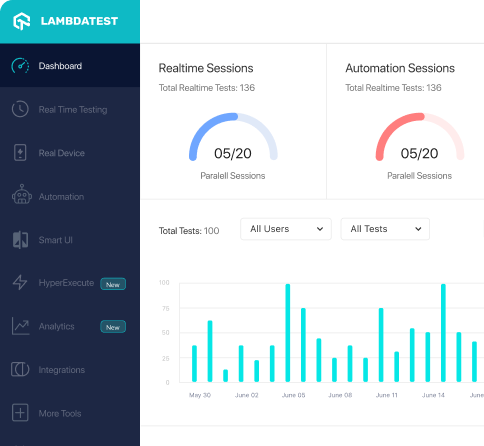How to use RegistryAuthLocator class of org.testcontainers.utility package
Best Testcontainers-java code snippet using org.testcontainers.utility.RegistryAuthLocator
...3import com.github.dockerjava.core.DockerClientConfig;4import com.github.dockerjava.core.DockerClientConfigDelegate;5import lombok.extern.slf4j.Slf4j;6import org.testcontainers.utility.DockerImageName;7import org.testcontainers.utility.RegistryAuthLocator;8import static org.testcontainers.utility.AuthConfigUtil.toSafeString;9/**10 * Facade implementation for {@link DockerClientConfig} which overrides how authentication11 * configuration is obtained. A delegate {@link DockerClientConfig} will be called first12 * to try and obtain auth credentials, but after that {@link RegistryAuthLocator} will be13 * used to try and improve the auth resolution (e.g. using credential helpers).14 *15 * TODO move to docker-java16 */17@Slf4j18class AuthDelegatingDockerClientConfig extends DockerClientConfigDelegate {19 public AuthDelegatingDockerClientConfig(DockerClientConfig delegate) {20 super(delegate);21 }22 @Override23 public AuthConfig effectiveAuthConfig(String imageName) {24 // allow docker-java auth config to be used as a fallback25 AuthConfig fallbackAuthConfig;26 try {27 fallbackAuthConfig = super.effectiveAuthConfig(imageName);28 } catch (Exception e) {29 log.debug("Delegate call to effectiveAuthConfig failed with cause: '{}'. " +30 "Resolution of auth config will continue using RegistryAuthLocator.",31 e.getMessage());32 fallbackAuthConfig = new AuthConfig();33 }34 // try and obtain more accurate auth config using our resolution35 final DockerImageName parsed = DockerImageName.parse(imageName);36 final AuthConfig effectiveAuthConfig = RegistryAuthLocator.instance()37 .lookupAuthConfig(parsed, fallbackAuthConfig);38 log.debug("Effective auth config [{}]", toSafeString(effectiveAuthConfig));39 return effectiveAuthConfig;40 }41}...RegistryAuthLocator
Using AI Code Generation
1package com.example.docker;2import org.junit.Test;3import org.testcontainers.containers.GenericContainer;4import org.testcontainers.containers.wait.strategy.LogMessageWaitStrategy;5import org.testcontainers.utility.RegistryAuthLocator;6import java.time.Duration;7public class DockerTest {8 public void test() {9 RegistryAuthLocator.setMode(RegistryAuthLocator.Mode.DEFAULT);10 GenericContainer container = new GenericContainer("docker.io/library/redis:latest")11 .withExposedPorts(6379)12 .withEnv("REDIS_PASSWORD", "password")13 .waitingFor(new LogMessageWaitStrategy().withRegEx(".*Ready to accept connections.*\\s")14 .withStartupTimeout(Duration.ofSeconds(60)));15 container.start();16 System.out.println("Redis: " + container.getContainerIpAddress() + ":" + container.getMappedPort(6379));17 }18}RegistryAuthLocator
Using AI Code Generation
1public class RegistryAuthLocatorTest {2 public void testRegistryAuthLocator() throws Exception {3 final RegistryAuthLocator registryAuthLocator = new RegistryAuthLocator();4 registryAuthLocator.setDockerConfig("src/test/resources/.docker/config.json");5 assertNotNull(registryAuth);6 }7}RegistryAuthLocator
Using AI Code Generation
1getAuthConfig(): RegistryAuth2toHeaderValue(): String3pullImageCmd(String image): PullImageCmd4withAuthConfig(RegistryAuth authConfig): PullImageCmd5exec(PullImageResultCallback callback): PullImageResultCallback6awaitCompletion(): Void7withTag(String tag): PullImageCmd8withRegistry(String registry): PullImageCmd9withAuthConfig(RegistryAuth authConfig): PullImageCmd10withAuthConfig(RegistryAuth authConfig): PullImageCmd11withAuthConfig(RegistryAuth authConfig): PullImageCmd12withAuthConfig(RegistryAuthLocator
Using AI Code Generation
1import org.testcontainers.DockerClientFactory2import org.testcontainers.utility.RegistryAuthLocator3def registryAuth = RegistryAuthLocator.instance().lookupAuthConfig("docker.io")4DockerClientFactory.instance().client.authCmd().withAuthConfig(registryAuth).exec()5DockerClientFactory.instance().client.pullImageCmd("alpine").exec(new PullImageResultCallback()).awaitCompletion()6DockerClientFactory.instance().client.removeImageCmd("alpine").exec()7DockerClientFactory.instance().client.createContainerCmd("alpine").withCmd("sh", "-c", "while true; do echo hello; sleep 1; done").exec()8DockerClientFactory.instance().client.startContainerCmd("containerId").exec()9DockerClientFactory.instance().client.stopContainerCmd("containerId").exec()10DockerClientFactory.instance().client.removeContainerCmd("containerId").exec()11DockerClientFactory.instance().client.logContainerCmd("containerId").withStdOut().exec(new LogContainerResultCallback()).awaitCompletion()12DockerClientFactory.instance().client.statsCmd("containerId").exec(new StatsCallback() {13 void onNext(Stats stats) {14 }15}).awaitCompletion()16DockerClientFactory.instance().client.eventsCmd().exec(new EventsResultCallback() {17 void onNext(Event event) {18 }19}).awaitCompletion()20DockerClientFactory.instance().client.listImagesCmd().exec().each { image ->21}22DockerClientFactory.instance().client.listContainersCmd().exec().each { container ->23}24DockerClientFactory.instance().client.statsCmd("containerId").exec(new StatsCallback() {25 void onNext(Stats stats) {26 }27}).awaitCompletion()28DockerClientFactory.instance().client.eventsCmd().exec(new EventsRegistryAuthLocator
Using AI Code Generation
1import org.testcontainers.containers.GenericContainer2import org.testcontainers.utility.RegistryAuthLocator3def authConfig = RegistryAuthLocator.authConfig("docker.io")4def registryConfig = new com.github.dockerjava.api.model.AuthConfigurations(authConfig)5def image = new com.github.dockerjava.api.model.Image()6image.withRegistry("docker.io")7image.withName("alpine")8image.withTag("latest")9def container = new GenericContainer(image, registryConfig)10container.start()11container.stop()Blogs
Check out the latest blogs from LambdaTest on this topic:
Have you ever struggled with handling hidden elements while automating a web or mobile application? I was recently automating an eCommerce application. I struggled with handling hidden elements on the web page.
Continuous integration is a coding philosophy and set of practices that encourage development teams to make small code changes and check them into a version control repository regularly. Most modern applications necessitate the development of code across multiple platforms and tools, so teams require a consistent mechanism for integrating and validating changes. Continuous integration creates an automated way for developers to build, package, and test their applications. A consistent integration process encourages developers to commit code changes more frequently, resulting in improved collaboration and code quality.
Agile software development stems from a philosophy that being agile means creating and responding to change swiftly. Agile means having the ability to adapt and respond to change without dissolving into chaos. Being Agile involves teamwork built on diverse capabilities, skills, and talents. Team members include both the business and software development sides working together to produce working software that meets or exceeds customer expectations continuously.
 QA testers have a unique role and responsibility to serve the customer. Serving the customer in software testing means protecting customers from application defects, failures, and perceived failures from missing or misunderstood requirements. Testing for known requirements based on documentation or discussion is the core of the testing profession. One unique way QA testers can both differentiate themselves and be innovative occurs when senseshaping is used to improve the application user experience.
QA testers have a unique role and responsibility to serve the customer. Serving the customer in software testing means protecting customers from application defects, failures, and perceived failures from missing or misunderstood requirements. Testing for known requirements based on documentation or discussion is the core of the testing profession. One unique way QA testers can both differentiate themselves and be innovative occurs when senseshaping is used to improve the application user experience.
Automation Testing Tutorials
Learn to execute automation testing from scratch with LambdaTest Learning Hub. Right from setting up the prerequisites to run your first automation test, to following best practices and diving deeper into advanced test scenarios. LambdaTest Learning Hubs compile a list of step-by-step guides to help you be proficient with different test automation frameworks i.e. Selenium, Cypress, TestNG etc.
LambdaTest Learning Hubs:
- JUnit Tutorial
- TestNG Tutorial
- Webdriver Tutorial
- WebDriverIO Tutorial
- Protractor Tutorial
- Selenium 4 Tutorial
- Jenkins Tutorial
- NUnit Tutorial
- Jest Tutorial
- Playwright Tutorial
- Cypress Tutorial
- PyTest Tutorial
YouTube
You could also refer to video tutorials over LambdaTest YouTube channel to get step by step demonstration from industry experts.
Most used methods in RegistryAuthLocator
- ObjectMapper
- RegistryAuthLocator
- instance
- lookupAuthConfig
- lookupUncachedAuthConfig
- findExistingAuthConfig
- authConfigUsingHelper
- authConfigUsingStore
- findAuthNode
- runCredentialProvider
- getCredentialProgramName
- effectiveRegistryName
- getGenericCredentialsNotFoundMsg
- discoverCredentialsHelperNotFoundMessage
- extractCredentialProviderErrorMessage
- runCredentialProgram
Try LambdaTest Now !!
Get 100 minutes of automation test minutes FREE!!



